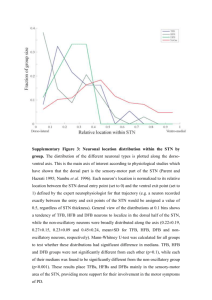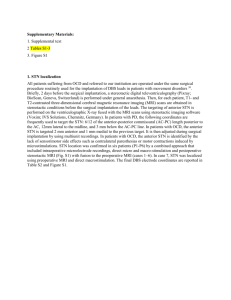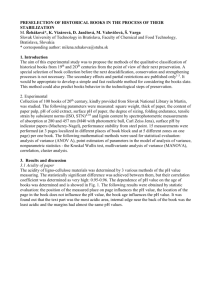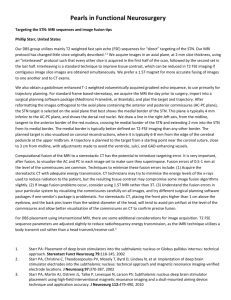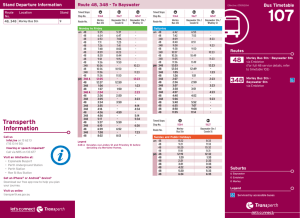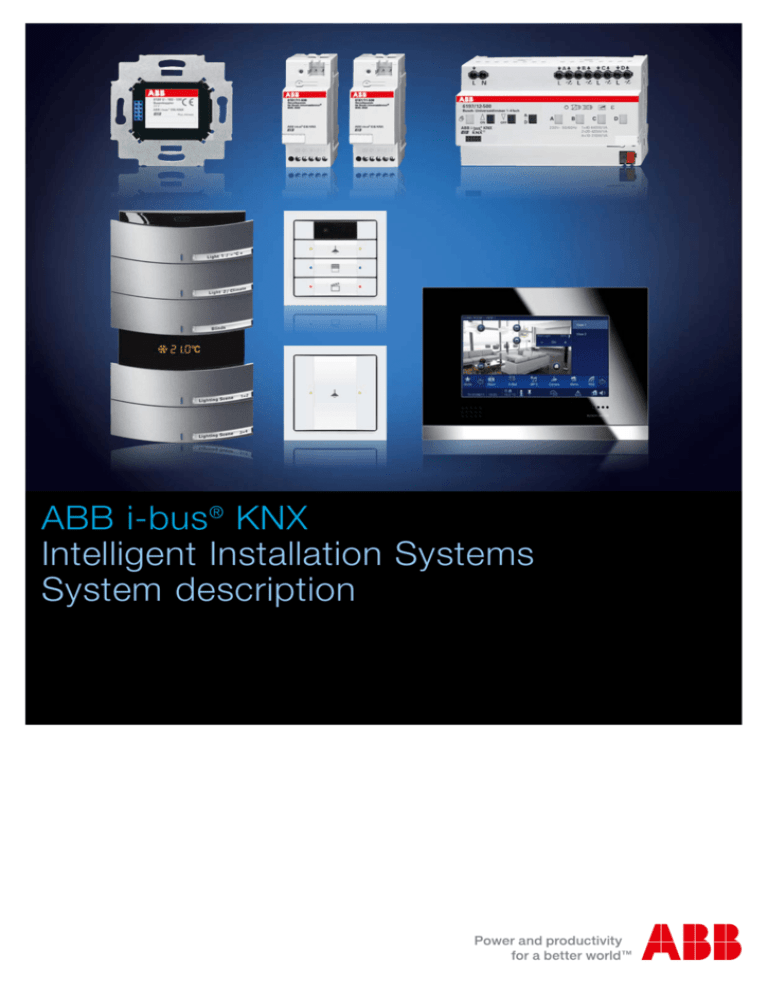
ABB i-bus® KNX
Intelligent Installation Systems
System description
Contents
1. Difference compared to the conventional
electrical installation
4
2. 2.1 2.2 2.3 2.4 ABB i-bus® KNX System Overview
General
Typical distribution structure for one line
Line topology
Distribution structure for several lines
5
6
7
8
3. 3.1 3.2
3.3
KNX Cost estimation
General
In the preplanning stage
In the execution planning stage 12
12
13
4. Physical address and group address
4.1 Physical address
4.2 Group address
14
14
5. 5.1
5.2
System Engineering
The European Tool Software (ETS)
The programming process
15
15
6. The commissioning process
16
7. Tips and Tricks
16
8. Planning support Busch-triton®
17
9. 9.1
9.2
9.3
10.
10.1
10.2
Electrical Design (Consulting)
General
Installation sheets
Circuit diagram
Documentation Examples
Distribution plan
General plan
18
19
20
22
23
ABB i-bus® KNX | Intelligent Installation Systems
3
1. Difference compared to the conventional
electrical installation
The so-called conventional electrical installation requires
not only
•supply lines for power transmission, but also a separate line
or wire
•for every switching command,
•or every measurement,
•for every message,
•for every controller or regulator.
!
All lines which are not required for power
trans­mission are replaced by a bus line in the
ABB i-bus® KNX system.
With KNX
Without KNX
Brightness sensor
Home
Living room
Child 1
Bedroom
Child 2
Kitchen
Lightings
Aisle
Blinds
Toilet
System
Central
23ϒC
13:45
Extras
Lighting
Home
Living room
Child 1
Bedroom
Child 2
Kitchen
Lightings
Aisle
Infrared
Panel for
visualization
System
Bus line
Power transmission line
The following illustration makes this clear:
•
•
•
The bus line is connected to an KNX power supply and all
the other stations (STN).
The 230 V line (or the 400 V line) is not required for the
control stations (STN) (sensors). It is only required for the power supply to the consumers.
As a consequence, there are 2 supply systems; one for
power transmission and one for information transmission.
230-V-50-Hz-power cable
Bus line e.g. JY (ST)-Y 2*2*0.8
4 Intelligent Installation Systems | ABB i-bus® KNX
Blinds
Toilet
Central
23ϒC
13:45
Extras
2. ABB i-bus® KNX System Overview
2.1 General
230 V
Power
supply
STN 1
STN 2
STN 3
STN 4
STN 5
STN 6
STN64
2.1 General
!
The KNX system operates decentrally and does not require a PC or any other special control unit after
start-up. The “intelli­gence” or rather the programmed
functions are stored in the stations (STN)
themselves.
There are four types of devices
• System devices:
Power supply and USB-interfaces. Connectors, choke,
line couplers and area couplers.
• Sensors:
Pushbuttons, trans­ducers (wind, rain, light, heat, etc.),
thermostats, analogue inputs
• Actuators:
Switching actuators, dimming actuators, actuators for blinds, heating actuators
Each STN can exchange information with any other STN by
means of telegrams. The lowest configuration level is referred
to as a line. A max. of 64 stations (STN) can be used in one
line. The actual number of stations (STN) depends on the
selected power supply and the power consumption of the
individual STN.
•
Controllers:
Sensors and actua­tors can be logically connected together
by means of controllers (logic unit, logic module or similar) for more complex functions.
2 STN can collaborate with a power supply via the bus line
in the smallest configuration. The installation bus progressively adapts itself to the size of the system and the required functions and can be extended to more than 57,000 STN.
ABB i-bus® KNX | Intelligent Installation Systems
5
2. ABB i-bus® KNX System Overview
2.2 Typical distribution structure for one line
2.2 Typical distribution structure for one line
Description of the device:
1.Residual-current-operated circuit breaker for
STN-distribution board
2.Miniature circuit-breakers; reserve one for the KNX
and the service socket
3.Socket for service work, e.g. for a laptop
4.KNX power supply (SV/S 30.640.5)
5.USB-Interface for service work with the laptop (USB/S1.1)
3
1
2
Explanation of the structure:
There are 2 power supplies of different sizes: 320 mA and
640 mA. In case of doubt, the larger power supply with 640
mA should be selected because there are some KNX users
that consume double or many times the power. The connection is made on the one hand to the low-voltage network (L,
N, PE) and, on the other hand, to the bus line (24 V). All users
belonging to the line and the power supply are connected via
this bus line.
As a third power supply, there is an uninterrupted KNX
power supply (SU/S 30.640.1), also 640 mA, which, in conjunction with a battery module (AM/S 12.1), maintains the
bus communication for 10 mins under full load.
5
4
+
L1
N
OK
!
The bus users are supplied exclusively. The advantage is that all object values of the users are retained and
“settling” of the system is not necessary. The other
consumers (lamps, roller blinds, PCs and monitors etc.) must be supplied via a separate UPS.
230V OK
q
Code
150 mA 650 mA
OK
ON
Direct bus access
(unrestricted power
supply)
I > I max
12V
Reset
30V DC
q
Code
150 mA 650 mA
12V
12V
OK
10 Minutes
Reset
6 Intelligent Installation Systems | ABB i-bus® KNX
Low-voltage supply with a battery
module for 10 minutes full load
2. ABB i-bus® KNX System Overview
2.2 Typical distribution structure for one line
2.3 Line topology
The bus line is led to the remaining stations (STN). We recommend using an KNX-certified bus line. In addition to the
requisite physical properties (number of cores, cross-section,
2.3 Line topology
Maximum distance
The wire lengths within a line
are limited. Total length max.
1000 m
Between power supply and
last user: max. 350 m
STN
STN
STN
5
STN
1
STN
max. 700 m
1
SV
STN
1
STN
2
STN
1
STN
2
STN
64
max. 700 m
STN
STN
STN
STN
5
4
Between two power supplies:
min. 200 m
SV
max. 350 m
2
Minimum distance
Maximum distance
Between two users:
SV
SV
max.
1000 m
isolation voltage, etc.), the bus line can be imme­diately distinguished from other weak-current lines. (e.g. YCYM 2 x 2 x 0.8
or J-Y (ST) Y 2 x 2 x 0.8).
2
STN
4
5
STN
STN
64
STN
5
4
STN
64
STN
4
min. 200 m
64
SV
SV = Power supply
STN = Station
Line
STN 2
STN 4
STN 5
STN 6
Star
230 V
STN 7
Power
supply
STN 1
STN 3
STN 8
STN 9
Ring not
permissible!
STN 3
STN 10
Tree
STN 15
STN 11
STN 18
STN 16
STN 12
STN 13
STN 17
STN 14
ABB i-bus® KNX | Intelligent Installation Systems
7
2. ABB i-bus® KNX System Overview
2.4 Distribution structure for several lines
2.4 Distribution structure for several lines
If there are more than 64 STN, or several parts of the building
are involved, with the result that it is necessary to bring in at
least a second line, the lines are connected together by means
of a line coupler. The so-called main line, which also requires a
power supply, forms the backbone of the line couplers.
A main line is topolo­gically structured like a line, with the only
difference that in a main line there are no sensors and actuators, but only a line coupler. During planning, max. 12 lines
should be used. Technically, 15 lines are possible. Lines 13 15 should be considered as reserves.
Schematically:
Main line
230 V
Power
supply
LC 1
LC 2
230 V
LC 12
230 V
Power
supply
230 V
Power
supply
Power
supply
STN 1
STN 1
STN 1
STN 2
STN 2
STN 2
STN 3
STN 3
STN 3
STN 4
STN 4
STN 4
STN 5
STN 5
STN 5
STN64
STN64
STN64
Line 1
8 Intelligent Installation Systems | ABB i-bus® KNX
Line 2
Line 12
2. ABB i-bus® KNX System Overview
2.4 Distribution structure for several lines
!
In practice, a new line should be configured with far less than 64 STN, so that the addition of a single STN does
not immediately require the installa­tion of a second line.
The line couplers are connected exclusively via bus terminals,
both for the line and for the main line.
Article no.
Uninterrupted power supply 640 mA SU/S 30.640.1
Battery module
AM/S 12.1
Line coupler
LK/S 4.1
TE
6 TE
8 TE
2 TE
Wiring:
230 V AC
L1
q
N
Code
150 mA 650 mA
12V
OK
Power
supply
Main line
230V AC
50 / 60 Hz
12V
30V
OK
30V DC
640 m A
Battery module
-5¡C ... 45¡C
230V OK
q
Code /
150 mA 650 mA
OK
ON
Un= 12 V DC
I > I max
12V
Reset
30V DC
230 V AC
LK
56
4
L1
q
N
Code
150 mA 650 mA
12V
12V
OK
ON
Main
Line
Line
230V OK
1 = Main Line
2 = Line
Line 1
q
Code /
150 mA 650 mA
OK
Power
supply
ON
STN 1
STN 2
STN 3
STN 4
STN 5
STN 6
STN 64
STN 1
STN 2
STN 3
STN 4
STN 5
STN 6
STN 64
STN 1
STN 2
STN 3
STN 4
STN 5
STN 6
STN 64
OK
Battery module
I > I max
Un= 12 V DC
12V
Reset
30V DC
230 V AC
LK
L1
q
N
Code
mA
150 mA
mA 650
150
Code
12V
12V
OK
ON
Main
Line
Line
230V OK
1 = Main Line
2 = Line
Line 2
q
Code /
150 mA 650 mA
OK
Power
supply
OK
Battery module
ON
Un= 12 V DC
I > I max
12V
Reset
30V DC
230 V AC
LK
L1
q
N
Code
150
150mA
mA Code
650 mA
12V
12V
OK
ON
Main
Line
Line
Line 12
OK
230V OK
1 = Main Line
2 = Line
q
Code /
150 mA 650 mA
Power
supply
OK
Battery module
ON
Un= 12 V DC
I > I max
12V
Reset
30V DC
STN = Station
ABB i-bus® KNX | Intelligent Installation Systems
9
2. ABB i-bus® KNX System Overview
2.4 Distribution structure for several lines
Up to 15 main lines can be combined in an area line if the
number of devices required in a project exceeds the capacity
of the 12 lines. Line and area couplers are identical units with
different designations on account of their use. Generally, they
are only referred to as couplers LK/S 4.1.
!
Stations (STN)
Lines
Areas
Stations (STN)
64 x 15
x 15
= 14,400
Line
Area
Installation Installation
Stations (STN)
Lines
Areas
Stations (STN)
255
x 15
x 15
= 14,400
Line
Area
Installation Installation
The maximum number of stations (STN) of an KNX installation with 64 or 255 STN per line.
Area line
For even larger installations, the topology can extended
through further measures to a max. of 255 devices per line.
Mathemati­cally, this results in a max. number of 57,375 stations (STN):
Power
supply
BK
ON
Main
Line
Line
1 = Main Line
2 = Line
Main line 2
BK
Power
supply
STN 1
1.1.1.
Line 1
LK
ON
Main
Line
Line
1 = Main Line
2 = Line
STN 2
1.1.2.
STN 3
1.1.3.
STN 4
1.1.4.
STN 5
1.1.5.
STN 6
1.1.6.
STN 64
1.1.64.
Power
supply
L1
q
N
Code
150 mA 650 mA
12V
ON
Main
Line
Line
230V OK
1 = Main Line
2 = Line
q
Code /
150 mA 650 mA
OK
Power
supply
OK
OK
Battery module
Un= 12 V DC
ON
I > I max
12V
Reset
30V DC
LK
56
4
L1
q
N
STN 1
Code
150 mA 650 mA
12V
12V
Line 1
Main line 1
24V-Busline
ON
Main
Line
Line
230V OK
1 = Main Line
2 = Line
q
Code /
150 mA 650 mA
OK
Power
supply
OK
OK
Battery module
Un= 12 V DC
ON
I > I max
12V
Reset
30V DC
STN 1
LK
1.2.1.
STN 2
1.2.2.
STN 3
1.2.3.
STN 4
1.2.4.
STN 5
1.2.5.
STN 6
1.2.6.
STN 64
LK
1.2.64.
L1
q
N
1 = Main Line
2 = Line
Line 2
Line
Power
supply
Line 12
STN 1
1.12.1.
LK
ON
Main
Line
Line
1 = Main Line
2 = Line
STN 2
1.12.2.
Power
supply
BK = Area coupler
STN 3
1.12.3.
STN 4
1.12.4.
STN 5
1.12.5.
STN 6
1.12.6.
STN 64
1.12.64.
Line
230V OK
1 = Main Line
2 = Line
q
Code /
150 mA 650 mA
OK
Power
supply
OK
STN = Station
10 Intelligent Installation Systems | ABB i-bus® KNX
OK
Battery module
Un= 12 V DC
ON
I > I max
12V
Reset
30V DC
L1
q
N
STN 1
Code
150
150mA
mA Code
650 mA
12V
12V
ON
Main
Line
Line
OK
230V OK
1 = Main Line
2 = Line
q
Code /
150 mA 650 mA
Power
supply
OK
OK
Battery module
Un= 12 V DC
ON
I > I max
12V
Reset
30V DC
LK = Line coupler
STN 1
12V
12V
Main
Line
LK
Line 12
Line 2
Main
Line
Code
mA
150 mA
mA 650
150
Code
ON
ON
Main line 15
STN 3
STN 4
STN 5
STN 6
STN 3
STN 4
STN 5
STN 6
1 = Main Line
2 = Line
LK
ON
Main
Line
Line
STN 1
STN 2
STN 3
STN 4
STN 5
STN 6
STN 64
STN 1
STN 2
STN 3
STN 4
STN 5
STN 6
STN 64
STN 6
STN 64
Power
supply
1 = Main Line
2 = Line
STN 64
Line 2
STN 2
Power
supply
Line
STN 64
Line 1
STN 2
BK
ON
Main
Line
System
coupler
230V/400V Information network
STN 3
STN 4
STN 5
STN 6
STN 64
Line 12
STN 2
System
coupler
STN 1
STN 2
STN 3
STN 4
STN 5
ABB i-bus® KNX | Intelligent Installation Systems
11
3. KNX Cost estimation
3.1 General
3.2 Cost estimation in the preplanning stage
3.3 Cost estimation in the execution planning stage
3.1 General
Simplified cost estimation methods can be applied depending
on these construction stages:
• preplanning
• execution planning
The objective is to portray the functionality in relation to cost.
The proposed models natu­rally can not provide exact results
that could be used in one form or another in the final calculations. Instead, the models ­illu­s­trate the ability to esti­mate cost
in com­parison with conven­tio­nal techno­logy or other systems.
Experience in the field has demon­strated that the costs for KNX
in functional buildings generally are not higher that those of an
alternative ­solution, since, even in buildings of lower standards,
the functions have a certain demand for automation.
For private properties, this is usually not the case, which
explains the additional cost. In such cases, the end customer
has to make a decision by weighting the resulting advan­tages.
3.2 Cost estimation in the preplanning stage
In terms of the electrical installation, preplanning simply entails
estimating the total costs based on the prototype of the buil­
ding to be constructed.
In doing so, a three-level, flatrate sum based on the squaremetre area of the building is often used to achieve this estimate. The so-called low, middle and raised standards used in
this estimation generally do not specify details with regard to
the individual assembly groups or their functions. This estimate
can be described from the perspective of the constructor or
investor as more or less a rough quote of the costs based on
the size of the building and the level of the equipment. Independent of the execution level, it can be said for non-residential
buildings that the cost of imple­menting KNX does not differ
from that of alternative solutions if KNX is to be used for automation tasks only. In the case of a lower standard, this can of
course mean, for example, that only a few central fault messages or timed switch functions can be taken on. Nevertheless,
even such limited implemen­tations have proved useful, as
unforesee­able changes to the requirements profile are made
continuously through­out the con­struc­tion phase. The adaptability of the KNX is, especially in this case, a great advan­tage.
For private properties, the implementation is ­worthwhile only if
there are increased require­ments on the electrical installation.
This for example could be the implementation of electric blinds
or a high-quality lighting control system with light scenes.
• In functional buildings, it is generally possible during the preplanning phase to start at cost neutrality, even if the costs are estimated flat rate and based on
squaremetres area.
• For private properties, the implementation of KNX makes financial sense only if there are increased
requirements.
!
3.3 Cost estimation in the execution planning stage
During the execution planning stage, the planner (generally the
installer for private properties) determines the functionality of
the electrical installation in co-operation with the client or the
client‘s agent inde­pendent of the system to be used.
The expected costs are then determined based on the functional description determined by the planner and client. Those
who are new to KNX frequently find it especially difficult to
estimate the costs. A frequent mistake is to base the estimate
on individual ­devices, which, without detailed context, often
appear „too expensive.“
12 Intelligent Installation Systems | ABB i-bus® KNX
However, it is possible to come to an estimation that is quite
accurate without great effort.
The cost estimate presented here is based on flat rates which
have been calculated according to list prices in the E zone.
The estimate is calculated in four steps.
• Determining the costs of active devices
• Determining the costs of system devices including
accessories
• Determining the costs of programming and commissioning
• Determining costs for special items
3. KNX Cost estimation
3.1 General
3.2 Cost estimation in the preplanning stage
3.3 Cost estimation in the execution planning stage
An example:
Requirements profile:
This example is intended to clarify the process of cost estimation. A new school is to be built. A meeting between ­builders
and building planners results in the following requirements
profile, which includes the implementation of KNX.
In the classrooms, the lighting is to be switched off based
upon outside bright­ness. In order to prevent interruptions, this
should occur only during breaks. In laboratories and other
special-pur­pose rooms, electric blinds are to be controlled in
addition to the lighting. Like­wise, the lighting of a break room is
to be switched off when sufficient outside light is present. Furthermore, several messages, which have not yet been detailed,
shall be provided.
Room list:
1. Determining costs for active devices
Active devices are all actuators and sensors that are part of the KNX. Instead of
calculating the actual, concrete device that is to be implemented, flat rates that
are based on specific functions are used in estimating the costs.
• Switched loads
120 €
• Dimmed loads
220 €
• Groups of blinds
180 €
• Heating circuit
with continuously regulated valves
400 €
with electro-thermal valves
260 €
• Message monitoring
60 €
Standard classrooms
40
Laboratories/special-purpose rooms
10
Break rooms
1
Auditoriums
1
Teacher rooms
2
Offices
5
Our example:
Switched loads
50 classrooms each with 3 lighting groups
1 break room with 4 light groups
154 light groups =
Blinds
10 special-purpose rooms (assuming
each has 2 groups of blinds)
Heating
No heating control with KNX
Message monitoring
Flat rate assuming
5 fault messages
Total active devices
300.00 €
20580.00 €
System devices
20580 € * 7% = Material costs
1440.60 €
22020.60 €
18480.00 €
1800.00 €
0.00 €
2. Determining costs for system devices
With the presumption that the individual KNX line is equipped with about 50
devices, and while assuming a mean price for active devices, it is possible to
assess the costs of the system devices as well.
Costs of system devices = 7% of the cost of active devices
3. Determining the service cost
Based on experience and using flat rates, it is possible to estimate the costs for
­programming and commissioning.
•Programming 10% of the cost of active devices
•Commissioning 5% of the cost of active devices
Important: The programming can require significantly more
time in ­private houses because each room can be assigned its own
individual functions. ­Simply copying functions from room to room, as is often
possible in commercial projects, frequently can not be done. In cases of complex application, programming costs of up to 20% of the cost of active devices
can be reckoned with.
!
Programming
20580 € * 10% = Commissioning
20580 € * 5% = Service 3087.00 €
Materials + service
2058.00 €
1029.00 €
25107.60 €
4. Special costs
Special costs include those which can not estimated on a flat-rate basis.
For example:
•Visualisations
•Integration with other systems
• ...
Price example of the German market.
In our example, visualisation of KNX fun­ctions is planned from a central location. Because the requirements profile is not very complex, we have chosen a
simple touch screen as the ­visualisation interface in our example.
Material costs
Touch screen
approx. 1000.00 €
Service
Graphic design and integration of the KNX data points approx. 500.00 €
Special costs
1500.00 €
Total cost of our example
26607.60€
ABB i-bus® KNX | Intelligent Installation Systems
13
4. Physical address and group address
4.1 Physical address
4.2 Group address
The set-up of the physical address is always the same:
Basically there are two different forms of address
Area 1
Line 4
Station 5
physical address
group address
4.1 Physical address
The physical address resembles a telephone number for each
individual participant. Thus, each physical address only occurs
once in an KNX project. From the physical address it is also
possible to determine the line that the STN can be found in.
}
1.4.5
Area 12
Line 4
Area 3
Area 2
Area 1
Line 1
Line 2
STN 1
STN 1
STN 1
STN 1
STN 1
STN 2
STN 2
STN 2
STN 2
STN 2
Line 3
STN 1
Line 4
STN 1
STN 1
STN 2
STN 2
STN 1
STN 2
STN 4
STN 2
STN 3
STN 5
STN 3
STN 4
STN 3
STN 3
STN 4
STN 3
STN 64
STN 4
STN 5
STN 4
STN 4
STN 5
STN 64
STN 64
STN 64
STN 4
STN 64
STN 64
STN 64
STN 5
STN 64
STN 64
STN 64
STN 64
4.2 Group address
The group address is a numbering of the individual functions. A
group address occurs at least twice in one project – once with
the sensor and once with the actuator. Since the same group
address is allocated to the sensor and the actuator, they are
functionally linked together. The group address sent from the
sensor is registered by the actuator and the respective switching process is carried out.
!
Station 5
STN 5
STN 64
STN 5
STN 64
STN 5
STN 4
STN 5
STN 64
STN 5
STN 64
STN 64
STN 4
STN 5
STN 64
STN 5
STN 5
STN 5
STN 4
STN 3
STN 64
STN 4
STN 5
STN 4
STN 5
STN 64
STN 5
STN 3
STN 4
STN 5
STN 4
STN 64
STN 4
STN 5
STN 3
STN 3
The division into main and STNgroup has become routine.
From the ETS 2 onwards a second form of addressing exists
on 3 levels, i.e. the main group, middlegroup and lower group.
Irrespective of the address form, up to 32,768 different group
addresses can be assigned in one project.
The physical address must be marked on each STN and on each corresponding control cover. If due to renovation work, for example, the control covers are removed from the bus couplings, they can be allocated correctly to the right bus couplings afterwards.
Addressing on 2 levels
Addressing on 3 levels
Main group
0 – 15 = 16 addresses
0 – 15 = 16 addresses
Middle group
0 – 7 = 8 addresses
Lower group
0 – 2,047 = 2,048 addresses0 – 255 = 256 addresses
Number of group addresses = 32,768 addresses
= 32,768 addresses
14 Intelligent Installation Systems | ABB i-bus® KNX
1.4.5
STN 4
STN 3
STN 2
STN 5
STN 3
STN 4
STN 3
STN 2
STN 5
STN 3
STN 4
STN 2
STN 2
STN 3
STN 2
STN 3
STN 2
STN 1
STN 4
STN 2
STN 3
STN 2
STN 2
STN 1
STN 1
STN 3
STN 1
STN 1
STN 4
STN 2
STN 3
STN 1
STN 1
STN 1
STN 3
STN 1
STN 2
STN 1
Line 12
STN 1
STN 3
Area 1
5. System Engineering
5.1 The European Tool Software (ETS)
5.2 The programming process
5.1 The European Tool Software (ETS)
The ETS is the standard software used for commissioning the
KNX. Unlike other systems, all manufacturers of KNX products
use the ETS to commission their devices. This guarantees
product compatibility between different manufacturers. The
product data can be obtained from the manufacturers free of
charge. The product data can be imported into the ETS by the
user without a problem.
The ETS is not free of charge and can be purchased through
the KNX: www.knx.org
Manufacturer‘s
­product database
Import/export
System functionality
Device functionality
ETS
Programming
Commissioning
Training programmes are offered in many countries through
certified training establishments. For more information on
training, please ask your representative.
5.2 The programming process
Programming the system in the ETS requires several steps.
Create the building structure (optionally)
Building, storeys and rooms/distributors of the project are
defined in the form of a tree structure.
Create the devices of the project
The devices required are added into the rooms/distributors and
their parameters are defined. Unique „physical addresses“ are
assigned to the devices (see diagram on the right)
Define the functions in the project
Each function is given a name, which serves as the so-called
group address (see diagram on the right)
Create the interconnections
Devices are linked via the group addresses, which is comparable to the layout and connection of control lines in the
­conventional technology.
ABB i-bus® KNX | Intelligent Installation Systems
15
6. The commissioning process
7. Tips and Tricks
6. The commissioning process
7. Tips and Tricks
To commission the system, the programmer‘s local computer
has to be connected to the KNX installation. The following
options can be used to achieve the connection:
1.To avoid having to set up a new line straight away if more
stations (STN) are added, do not plan more than 40 to 45
station (STN) per line for the ABB i-bus® KNX.
• Serial COM port
• USB port (with ETS3 and later)
• LAN/ISDN gateway (remote maintenance)
Once one of these connections has been established, the next
step is to load the physical addresses into the device. This
requires pressing a programming button on the device once.
After this is done, the ­so-called applications (which comprise
the actual device program) can be loaded. This takes place via
the bus, without having to access the device manually.
2.Adapt the bus structure to the building, e.g. one line for
each floor. This increases the clarity of a project.
3.The certified bus line has two pairs of wires. The first pair
(black and red) is needed immediately; the second pair can
be used later, or if necessary, for another purpose. Therefore it is advisable to wire this second pair of wires straight
away in all the branching boxes, etc..
4.In larger ABB i-bus® KNX systems, is it recommendable
to create several programming possibilities. This means
providing a serial interface in several places (for the bus
connection) and a socket (if necessary, for the laptop).
5.Use a certified bus line that has the necessary physical
properties on the one hand (number of wires, cross-section,
insulating voltage) and is easy to distinguish from other
weak-current lines, on the other. Possible cable types are:
JY (ST)Y 2x2x0.8 or PYCYM 2x2x0.8.
6.Basically, there are two possibilities for placing the actuators in a building - either decentrally in suspended ceilings,
or centrally in STN-distributions. Both possibilities have their
advantages:
Decentral
•
•
•
•
less installation work
fewer lines, which means
lower fire load and smaller cable runs
smaller STN-distributions
Central
• the devices are more easily accessible
• the devices are clearly positioned
16 Intelligent Installation Systems | ABB i-bus® KNX
8. Planning support Busch-triton®
Installation
location:
Room:
Switch rocker functions:
Switch
rocker 1
Switch
rocker 2
Switch
rocker 3
Switch
rocker 4
Switch
rocker 5
Socket outlet
1gang
3gang
Infrared
Socket outlet
3gang RTR
Infrared
Socket outlet
5gang
Infrared
5gang RTR
Infrared
Other remarks:
ABB i-bus® KNX | Intelligent Installation Systems
17
9. Electrical Design (Consulting)
9.1 General
9.2 Installation sheets
9.1 General
Recommendations for ­planning with KNX:
Planning with KNX differs ­little from planning based on conventional techniques. There are two ­differences, how­ever, which the
planner needs to consider.
Field experience has shown that the less experienced tend to
offer the KNX as a separate item. This leads to the following
disadvantages:
1.The specification (bid) should include a detailed functional
description, as the functionality generally can not be determined from the bid devices. This functional description allows
the tendering company (usually the installer) to estimate the
input required for programming the building being constructed.
• Only with difficulty can the tendering installer make correlations between the various assembly groups.
• The constructor gets the impression that the KNX is an
optional item that can be re­moved from the bid. This of course
is the case only if an alternative ­system is implemented (which
often requires further measures) or if the parties renounce
agreed solutions.
2.The layout of the KNX should be illustrated in a diagram. This
provides additional information on time and cost requirements
and illustrates the planned structure of the project.
(Refer to „Topology“.)
!
Note: Programming the devices generally is not included
in the planning. Instead, this service is provided by the
company carrying out the installation or by a specialised service provider.
18 Intelligent Installation Systems | ABB i-bus® KNX
This can be avoided by ­integrating the planned implementation
into the standard segmentation of the specification (e.g. lighting,
heating...) bid.
9. Electrical Design (Consulting)
9.1 General
9.2 Installation sheets
9.2 Installation sheets
Like planning using con­ventional technology, the installation
plan provides information on the special positioning of the
instal­lation devices, the function can not be mirrored in the plan
because the function is ultimately determined when the devices
are programmed, not when they are installed.
ABB i-bus® KNX | Intelligent Installation Systems
19
9. Electrical Design (Consulting)
9.3 Circuit diagram
9.3 Circuit diagram
The KNX distributor devices are represented in the circuit
diagrams by block symbols. The single-line diagram is the most
common in the plan. Multiline diagrams are needed only in
special cases and in revision plans.
20 Intelligent Installation Systems | ABB i-bus® KNX
ABB i-bus® KNX | Intelligent Installation Systems
21
F
E
File:
AutoCAD R14
Condition
Date
1.2
N PE
Change
1
Name
Standard
Tested
Proc.
Date
2
NHXMH-J
3x2.5
1.1
1.2
NHXMH-J
3x2.5
N PE
-X1
K2.1
ESB20
bw
2.5
Cable
Electric
circuit
1.1
-X1
bw
2.5
B
Description
D
PE
003.8
N
A
Switch actuator, 4-fold, 16A
Lighting
Court room
C
E11
1.3.51
Lighting
Court room
All rights are reserved for this document, even in case of issuance of
a patent and registration of another industrial right. Misapplication, in
particular reproduction or handing over to third parties is prohibited
and actionable under civil and criminal law.
All rights are reserved for this document, even in the case of issuance of
a patent and registrations of another industrial right.
Misapplication, in particular, reproduction
or handing over to third persons is prohibited and actionable under civil and
criminal law.
B6A
A2
A1
2.1
C
Orig.
2.2
2.2
-X1
D
-X1
3
Ers.f.
E12
3.2
3.2
-X1
4
ABB Gebäudetechnik AG
Ers.d.
K4.1
N PE
ESB20
bw
2.5
NHXMH-J
3x2.5
3.1
N PE
bw
2.5
B
NHXMH-J
3x2.5
2.1/2
-X1
A
Switch actuator, 4-fold, 16A
3.1
B16A
F3
N PE
bw
2.5
1.3.52
NHXMH-J
5x2.5
4
2
2.2.2
3
1
2.1/1
N PE 2.2.1
bw
2.5
NHXMH-J
3x2.5
B16A
Lighting
Court room
B16A
Control
Court room
F2
Lighting
Court room
F03
Lighting
Court room
F1
Lighting
Court room
1L1-1L2-1L3
003.8
Lighting
Court room
B
.
A2
A1
4.1
C
Control
Court room
A
4.2
4.2
-X1
D
General plan
Sub-distribution
Roofed hall
Fine network
5
N PE
bw
2.5
NHXMH-J
3x2.5
B16A
F4
Lighting
Court room
L1-L2-L3
003.8
E13
6
N PE
6.1
6.1
-X1
N PE
bw
2.5
6.2
6.2
-X1
D
N PE
bw
2.5
7
B
NHXMH-J
3x2.5
5.2
5.2
-X1
bw
2.5
C
NHXMH-J
3x2.5
N PE
bw
2.5
B
NHXMH-J
3x2.5
5.1
6
B16A
NHXMH-J
3x2.5
4.1/2
-X1
A
7
F6
Switch actuator, 4-fold, 16A
5.1
B16A
F5
N PE
bw
2.5
1.3.53
NHXMH-J
5x2.5
4
2
4.1.2
3
1
4.1/1
4.1.1
-X1
F03
005.5
Lighting
Court room
5
Lighting
Court room
4
Lighting
Court room
3
Lighting
Court room
2
Lighting
Court room
22 Intelligent Installation Systems | ABB i-bus® KNX
Lighting
Court room
1
8
PE
005.1
N
Sheet
1L1-1L2-1L3
005.1
L1-L2-L3
005.1
8
004
Sh.
F
E
D
C
B
A
10. Documentation Examples
10.1 Distribution plan
10. Documentation examples
10.2 General plan
ABB i-bus® KNX | Intelligent Installation Systems
23
A member
of the ABB Group
Busch-Jaeger Elektro GmbH
P.O.Box
58505 Lüdenscheid
Freisenbergstraße 2
58513 Lüdenscheid
Germany
www.BUSCH-JAEGER.com
info.bje@de.abb.com
Central sales service:
Phone:+49 (23 51) 9 56-0
Fax: +49 (23 51) 9 56-13 80
BJE 0001-0-0156/2.11/0502-D, dpi 405739
Contact us

